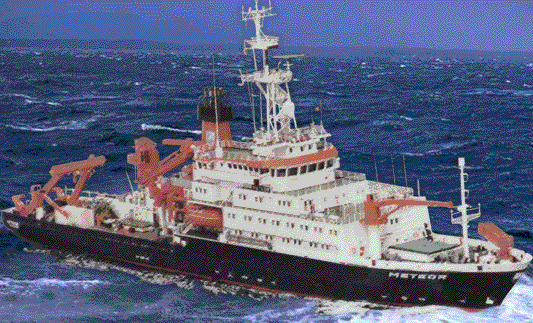R/V Meteor, Technical Details and History
The R/V Meteor is owned by the Federal Republic of Germany through the Ministry of Research and Technology (BMFT), which financed its construction. It is operated by the German Research Foundation (DFG), which provides about 70% of its operating funds (the BMFT supplies the remainder). DFG also plans the scientific cruises and appoints the chief scientists. The Operations Control Office of the University of Hamburg is responsible for management, logistics, execution and supervision of ship operations. These functions are exercised by direct cooperation with expedition coordinators and the managing owners, the Reedereigemeinschaft Forschungsschiffahrt GmbH, located in Bremen, Germany. The latter is responsible for hiring, provisioning, and coordinating ship maintenance. Used for ocean research, primarily in the Atlantic and Indian Oceans, the R/V Meteor routinely carries scientists from many different countries. The R/V Meteor was completed in 1986 in Travemunde, Germany. The basic features of the vessel follow:
- Port of registration: Hamburg
- Call sign: DBBH
- Classification: GL+100A4E2+MC Auto
- Operator: University of Hamburg, Institute for Ocean Research
- Built: 1985-1986 at Schlichting Werft, Travemunde
- Gross registered tonnage: 3990
- Net registered tonnage: 1284
- Displacement: 4780 t
- Length overall: 97.50 m
- Beam: 16.50 m
- Draught max.: 5.60 m
- Service speed: 12 kn
- Depth main deck: 7.70 m
- Personnel: Crew: 32; Scientists: 30
- Main engine: 4 x Mak6M 322 = 4 x 1000 kW at 750 rpm
- Propulsion: diesel-electrical, tandem-motor = 2 x 1150 kW
- Fuel consumption: approximately 12.0 t IFO-80 per day at service speed
- Maximum cruise duration: 60 days
- Nautical equipment: Integrated navigation system with data transfer to position computer, echosounder synchronization and supervision, and data-processing facility
- Science quarters: 20 laboratories on the main deck with ~400 m2 of working space for multidisciplinary research
Meteor (I) was constructed in 1925, the first research and survey vessel of that name. Owned
by the German navy, it was based in Wilhelmshaven. One of its first expeditions was the German
Atlantic Ocean Expedition of 1925-1927, which was organized by the Institute of Marine
Research in Berlin. Thereafter, the vessel was used for German physical, chemical, and
microbiological marine investigations and for navy surveying and fisheries protection duties.
Meteor (II) was planned after the 1950s; it was operated by the Deutsche
Forschungsgemeinschaft (German Science Community) in Bad Godesberg and the Deutsches
Hydrographisches Institut (German Hydrographic Institute) in Hamburg. Commissioned in 1964,
Meteor (II) participated in the International Indian Ocean Expedition.
Multipurpose Meteor (III), used on the cruise described in this documentation, was completed in 1986, replacing Meteor (II). Based in Hamburg, it is used for German ocean research worldwide and for cooperative efforts with other nations in this field. The vessel serves scientists of all marine disciplines in all of the world's oceans.

